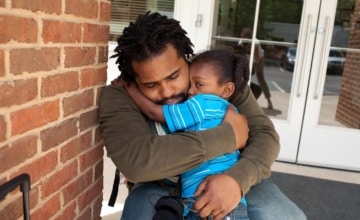Dogs, vacuums, and the dark—oh my!
Your brave little baby has turned into a terrified toddler. Here’s what you should know: It’s normal for little ones to become more fearful sometime around 12 months of age. (Learn more about what to expect at each age here.)
Never fear – there are strategies you can use to reassure and comfort a frightened child (and a few things to avoid too!). Get the details here.
What to Do
- Help your child put their fears into words. If your child expresses a fear of dogs, you can say something like, “Dogs make you feel a little unsure. You don’t like when they bark loudly.”
- Help your child feel secure. Make it clear what you’re doing to protect your child: “I know you worry about dogs, so I will carry you while we go inside to pick up your brother.”
- Move on with life. If you make too big a deal out of your child’s fear, you run the risk of giving the fear more power. For example, if your three-year-old tells you they are afraid of their dark bedroom at bedtime and you swoop in and move them to your bed, they are learning that their bedroom is, actually, a pretty scary place to sleep!
- Give your child tools. Suggest age-appropriate fear-busting strategies. You might say, “The night-time shadows can be a little spooky. Would you like me to turn on the lamp? Would you like to choose a special stuffed animal to cuddle? I will sit with you for a few minutes while you get cozy again.”
- Offer encouragement, and be patient. Working through fears, especially for a toddler or preschooler, takes time—especially since they still believe in monsters and all the creatures that live in their imaginations. Offer a consistent, caring response and notice when your child makes progress: “It was so brave of you to pet Maddie. She is a sweet dog.”
For information about how to respond to specific fears (the doctor, the dark, people wearing costumes, the vacuum cleaner), check out this resource.
What to Avoid
Even though you may not find the neighbor’s kid in the ketchup bottle costume very frightening on Halloween, your toddler may be spooked. Here are some tips:
- Avoid laughing at your child’s fear. Instead, validate their feelings: “That ketchup costume is a little strange, isn’t it?” Or you can try, “I know you feel unsure about that costume.”
- Avoid telling your child there is “nothing to be afraid of” or that “it’s not scary.” It is… to them. Instead, help your child understand there is no threat: “That’s Nicky from next door. He covered his face to look like a bottle of ketchup. But it’s still Nicky inside and he’s our friend.” (Ask Nicky to peek out and show your child his face.)
- Avoid forcing your child to be “brave.” Instead, provide support so your child can slowly face their fear in steps: “Would you like to wave at Nicky?” Then, “Would you like to give Nicky some Halloween candy?” Let your child decide what actions they feel safe taking.
When children are feeling fearful, their parents are their rock. So don’t fear your child’s fear—instead use these moments as another opportunity to strengthen your bond and let your child know they can come to you with any problem, big or small.





